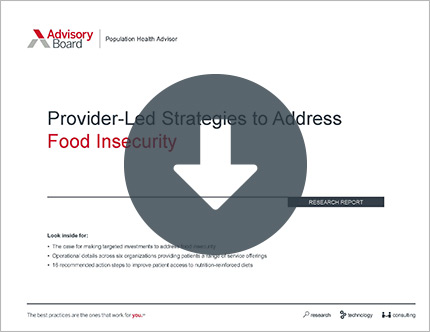Read Advisory Board's take: How can providers address poor nutrition?
More than one-third of Americans eat some kind of fast food on any given day, according to a report published by the CDC's National Center for Health Statistics.
What counts as fast food?
The report is based on data from CDC's National Health and Nutrition Examination Survey for 2013 through 2016. To gauge daily fast food consumption, CDC asked respondents where they obtained the food they ate in the last 24 hours. CDC considered "restaurant fast food/pizza" as fast food.
How many Americans eat fast food?
According to the report, 36.6% of Americans eat some form of fast food on a given day.
Overall and for most meals, men were more likely than women to eat fast food, though women were more likely to eat fast food as a snack. Overall, 37.9% of men and 35.4% of women ate fast food on a given day between 2013 and 2016.
Lunchtime was the most popular time of day to eat fast food, with 43.7% of respondents' eating it for lunch, while nearly one-quarter of respondents said they had a fast food snack on a given day.
Perhaps one of the more surprising findings of the report was fast food's popularity based on income level. The report found that higher-income residents are more likely than lower-income residents to eat fast food.
Among people whose family income was less than or equal to 130% of the federal poverty line (FPL), which was $11,770 for a single person or $24,250 for a family of four in 2016, just under a third had fast food on any given day. However, 36.4% of middle-income families (between 130% and 350% of FPL) and 42% of high-income families (above 350% of FPL) ate fast food on a given day.
Fast food consumption decreased with age, according to CDC. The survey found 44.9% of Americans ages 20-39 ate fast food on any given day, but just 24.1% of Americans 60 and over did so.
The report also found that fast food consumption varied by race. African-Americans were the most likely to eat fast food on a given day, while Asian Americans were least likely.
Some surprising, and unsurprising findings
Lawrence Cheskin, an associate professor and director of clinical research at the Global Obesity Prevention Center at Johns Hopkins Bloomberg School of Public Health, said the findings about fast food consumption and income were surprising. "That connection or correlation is opposite of what I perhaps would have expected," he said. "But we need these kinds of studies and these kinds of facts and statistics to get a better understanding of what drives the use of foods that, as a nutrition expert I would say, are not your first choice for a variety of reasons."
America's obesity crisis, mapped
Liz Weinandy, a registered dietitian at the Ohio State University Wexner Medical Center, said adults can eliminate fast food from their diet by "go[ing] to the grocery store more and prep[aring] food to take on the go so we don't have to get in a situation where we need to rely on fast food so much." Weinandy acknowledged that this can take "time and some organization" but said it can be done successfully if adults "take a couple of hours on the weekend, and again midweek, to prep food and then plan ahead just a little to take some things with them" (Kaplan, Los Angeles Times, 10/3; Howard, CNN, 10/3).
Advisory Board's take

Tomi Ogundimu, Practice Manager, Population Health Advisor
The results of this new report are extremely concerning given the ample evidence connecting frequent fast food consumption to an increased risk of obesity and the development of chronic conditions (like heart disease and Type 2 diabetes). As poor nutrition habits get magnified on a population level, they become one of the leading drivers of death and disability in the U.S., and account for a significant proportion of health care spending.
“For providers, poor nutrition is often an invisible challenge with an outsized impact on patient health”
For providers, poor nutrition is often an invisible challenge with an outsized impact on the health of those diagnosed with, or at-risk of developing, chronic conditions. And providers are beginning to take notice. As we've seen organizations start to think through how to address obesity in their markets, several are honing in on poor diets as an important root cause.
There are two things providers can start doing today to combat fast food consumption among their patient population:
- Reframe nutrition as a health issue. Most people do not think about the interlocking effects that food has on clinical care needs. Yet, by harnessing nutritional education, providers have a real opportunity to improve clinical outcomes.
Several organizations have begun employing an in-practice nutritionist to take patient visits or have used group visits as a forum for educating patients on how to make more healthy decisions at home. For example, Scripps Health in California has developed Project Dulce, an innovative skills-based education program which provides practical guidance on daily activities for managing diabetes. Part of the key to the program's success is that it directly translates in-classroom education to real-world situations. For example, immediately after patients learn key concepts for understanding food labels, they begin to apply these concepts in planning healthy meals.
Download two of Scripps' lessons on reading food labels and the plate method here.
- Help patients more easily access to healthy food. For those living at or near the poverty line, or in food deserts without nearby healthy options, options for quick meals outside of fast food may be limited. To help, providers can launch community partnerships aimed at providing greater patient access to more condition-specific, healthy foods by:
- Making connections to government benefits, e.g., providing SNAP enrollment assistance or having an on-campus WIC office
- Providing vouchers to local farmers markets and other low-cost produce sources
- Launching 'food pharmacies' (i.e., onsite food banks) to where patients can get referrals through 'food prescriptions'
For example, Lankenau Medical Center in Pennsylvania partnered with the nonprofit organization Greener Partners to develop and maintain an on-site farm which provides fresh and free produce to patients in need. To decide where to provide these additional nutritional services, Lankenau used zip codes to identify the most at-risk communities in its service area.
To learn more about how to address food and nutrition in your community, register now for our webconference on November 19th from 3-4:00 pm ET. We'll be talking with a leader at Hurley Medical Center in Michigan to learn how they formed community partnerships and built their Food FARMacy program.
In the meantime, be sure to read our research report on Provider Led Strategies to Address Food Insecurity, which provides 16 action steps to improve patient access to nutrition-reinforced diets.
Don't miss out on the latest Advisory Board insights
Create your free account to access 2 resources each month, including the latest research and webinars.
Want access without creating an account?
You have 2 free members-only resources remaining this month remaining this month.
1 free members-only resources remaining this month
1 free members-only resources remaining this month
You've reached your limit of free monthly insights
Become a member to access all of Advisory Board's resources, events, and experts
Never miss out on the latest innovative health care content tailored to you.
Benefits include:
You've reached your limit of free monthly insights


